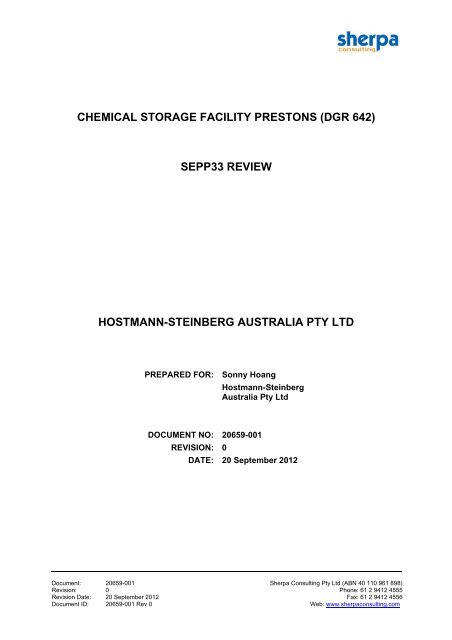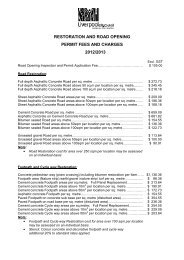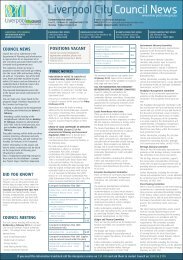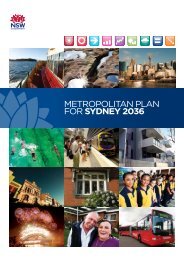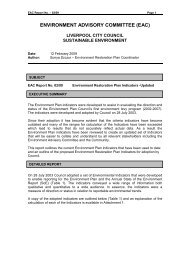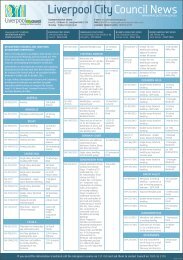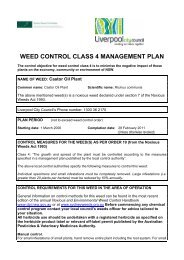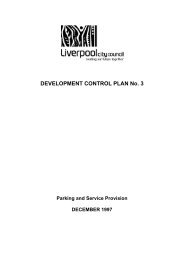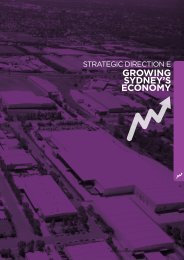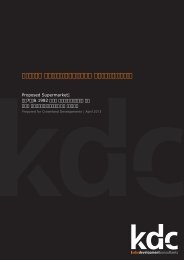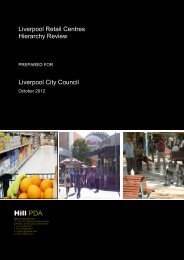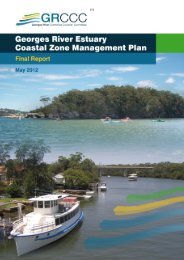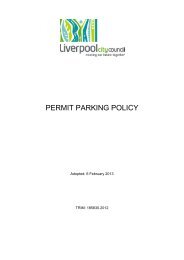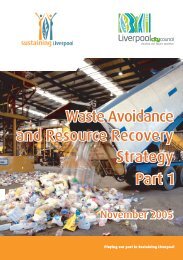sepp33 review hostmann-steinberg australia pty ltd
sepp33 review hostmann-steinberg australia pty ltd
sepp33 review hostmann-steinberg australia pty ltd
- No tags were found...
Create successful ePaper yourself
Turn your PDF publications into a flip-book with our unique Google optimized e-Paper software.
DOCUMENT REVISION RECORDREV DATE DESCRIPTION PREPARED CHECKED APPROVEDMETHODOF ISSUEA 31-Aug-12 Draft for client comment M. Chin P. Johnson P. Johnson Email[pdf]0 20-Sep-12 Final Issue to client M. Chin P. Johnson P. Johnson Email[pdf]RELIANCE NOTICEThis report is issued pursuant to an Agreement between SHERPA CONSULTING PTY LTD (‘SherpaConsulting’) and Hostmann-Steinberg Australia Pty Ltd which agreement sets forth the entire rights,obligations and liabilities of those parties with respect to the content and use of the report.Reliance by any other party on the contents of the report shall be at its own risk. Sherpa Consultingmakes no warranty or representation, expressed or implied, to any other party with respect to theaccuracy, completeness, or usefulness of the information contained in this report and assumes noliabilities with respect to any other party’s use of or damages resulting from such use of any information,conclusions or recommendations disclosed in this report.Title:Chemical Storage Facility Prestons (DGR 642)SEPP33 ReviewQA Verified:P. JOHNSONDate: 20 September 2012Document: 20659-001Revision: 0Revision Date: 20 September 2012Document ID: 20659-001 Rev 0Page 2
TABLESTable 2.1: SEPP 33 Hazardous Material Storage Screening Summary .......................................... 8Table 2.2: SEPP 33 Hazardous Material Transport Screening Summary (Ref 1) ......................... 10FIGURESFigure 2.1: Site Layout Drawing....................................................................................................... 12Figure 2.2: Site Layout Drawing Showing the Storage Locations for Dangerous Goods ................ 13Document: 20659-001Revision: 0Revision Date: 20 September 2012Document ID: 20659-001 Rev 0Page 4
ABBREVIATIONSADGDGDGRDoPEPLHSAmNSWPGPHASEESEPPAustralian Dangerous GoodsDangerous GoodsDirector-Generals RequirementDepartment of PlanningEnvironmental Protection LicenceHostmann-Steinberg Australia Pty LtdmetresNew South WalesPacking GroupPreliminary Hazard AnalysisStatement of Environmental EffectsState Environmental Planning PolicyDocument: 20659-001Revision: 0Revision Date: 20 September 2012Document ID: 20659-001 Rev 0Page 5
1. INTRODUCTION1.1. BackgroundHostmann-Steinberg Australia Pty Ltd (HSA) has undertaken the fit-out and use of anexisting building for the re-packaging and blending of imported ink for distributionthroughout Australia.HSA has engaged Sherpa Consulting Pty Ltd (Sherpa) to carry out the hazards andrisk component of the Director-Generals Requirements (DGR 642) under thisdesignated development. As part of this process, Sherpa is to <strong>review</strong> the developmentusing the State Environmental Planning Policy 33 – Hazardous and OffensiveDevelopment (SEPP 33) of the proposed development and determine whether it wouldbe considered by SEPP 33 to be ‘potentially hazardous industry’ or ‘potentiallyoffensive industry’.1.2. SEPP 33 ApplicabilitySEPP 33 links the permissibility of an industrial development to its offsite safety andenvironmental risks. Developments that involve storage, handling, or processingmaterials which, in the absence of locational, technical or operational controls, maycreate an off-site risk or offence to people, property or the environment are defined bySEPP 33 as ‘potentially hazardous industry’ or ‘potentially offensive industry’.Development proposals that are classified as potentially hazardous industry mustundergo a Preliminary Hazard Assessment (PHA) to determine the risk to people,property and the environment. If the residual risk exceeds the acceptability criteria, thedevelopment is ‘hazardous industry’ and may not be permissible within NSW.Developments that have the potential to emit contaminants to the environment andwhich require an Environmental Protection Licence (EPL) are ‘potentially offensive’.1.3. Scope and ObjectivesThe objectives of the SEPP 33 <strong>review</strong> are to: Determine whether the project is ‘potentially hazardous’, hence establishwhether a PHA is required and document the basis for the decision.Determine whether the project is ‘potentially offensive’, and document the basisfor the decision.1.4. MethodThe screening process published in the NSW Department of Planning guidelineHazardous & Offensive Development Application Guidelines – Applying SEPP 33(January 2011) was used to establish whether the development is ‘potentiallyhazardous’ or ‘potentially offensive’.Document: 20659-001Revision: 0Revision Date: 20 September 2012Document ID: 20659-001 Rev 0Page 6
2. SEPP 33 ASSESSMENT2.1. Potentially Hazardous DevelopmentSEPP 33 defines potentially hazardous industry as follows:‘Potentially hazardous industry’ means a development for the purposes of an industry which, ifthe development were to operate without employing any measures (including, for example,isolation from existing or likely future development on other land) to reduce or minimise its impactin the locality or on the existing or likely future development on other land, would pose asignificant risk in relation to the locality:(a) to human health, life or property; or(b) to the biophysical environment, and:includes a hazardous industry and a hazardous storage establishment.To determine whether a proposed development is potentially hazardous, the riskscreening process in the Applying SEPP 33 guideline considers the type and quantityof hazardous materials to be stored on the site and the distance of the storage area tothe nearest site boundary, as well as the expected number of transport movements.‘Hazardous materials’ are defined within the Applying SEPP 33 guideline assubstances that fall within the classification of the Australian Dangerous Goods Code(ADG), ie have a Dangerous Goods (DG) classification.2.2. Dangerous GoodsA list of the types and quantities of materials stored or handled at the development,together with the relevant SEPP 33 screening threshold is presented in Table 2.1. Theinformation was based on the ADG Assessment Report (Ref 3), but for the quantity ofaerosols this was reduced to four hundred, 300 gram cans after discussion with HSA.The proportion of propellant (and thus Class 2.1 Dangerous Good) in each can wasdetermined to be 10-30% w/w (Ref 2). 30% w/w hydrocarbon propellant was used asthe basis of calculation to account for worst case scenario.Table 2.1 shows that all inventories stored on site do not exceed the SEPP 33screening threshold and thus proposed development is not ‘potentially hazardous’.A site layout is presented in Figure 2.1; and a layout showing the site boundary inrelation to the Dangerous Goods storage locations is shown in Figure 2.2.Document: 20659-001Revision: 0Revision Date: 20 September 2012Document ID: 20659-001 Rev 0Page 7
TABLE 2.1:SEPP 33 HAZARDOUS MATERIAL STORAGE SCREENING SUMMARYMaterial DG Class TotalQuantity(tonne)Distance toNearest SiteBoundary (m)SEPP 33 ThresholdSEPP 33 DeterminationFlammable gas 2.1 0.036 15 Figure 6 (Ref 1):Based on 0.1 tonnes of Class 2.1 Other Usethreshold.Based on 0.1 tonnes of Class 2.1 Sensitivethreshold.Flammable liquid 3 PG II 3 17 Figure 9 (Ref 1):Based on 5 tonnes of Class 3 PG II Other Usethreshold.Based on 5 tonnes of Class 3 PG II Sensitivethreshold.Flammable liquid 3 PG III 1.6 17 Figure 9 (Ref 1):Based on 5 tonnes of Class 3 PG II Other Usethreshold.Based on 5 tonnes of Class 3 PG II Sensitivethreshold.Total Class 2.1 storage does not exceed SEPP 33threshold. Development is not potentially hazardous.Total Class 3 PG II storage does not exceed SEPP33 threshold. Development is not potentiallyhazardous.Total Class 3 PG III storage does not exceed SEPP33 threshold. Development is not potentiallyhazardous.Corrosivesubstances8 PG III 0.016 15 Table 3 (Ref 1):50 tonnes based on Class 8 PG IIITotal Class 8 PG III storage does not exceed SEPP33 threshold. Development is not potentiallyhazardous.Miscellaneousdangerous goodsBulk combustibleliquidsPackagedcombustible liquids9 PG III 0.5 15 No threshold identified. Figure 4 (Ref 1):Class 9 PG III not potentially hazardous material asper SEPP 33.C1 764 17 As per SEPP 33, if C1 is present on site and is stored in a separate bund or within a storage areawhere there are no Class 3 Flammable Liquids, they are not considered to be potentially hazardous.C1 364 17 Class 3 PG II and Class 3 PG III are stored separately in a flammable liquids cabinet.Document: 20659-001Revision: 0Revision Date: 20 September 2012Document ID: 20659-001 Rev 0Page 8
2.3. Transportation IssuesA list of expected types and quantities of hazardous materials transport movements toand from the site together with the relevant SEPP 33 screening thresholds ispresented in Table 2.2.The transport screening threshold are not exceeded by the proposed numbers ofhazardous material movements hence a Transport Route Selection study is notrequired.Document: 20659-001Revision: 0Revision Date: 20 September 2012Document ID: 20659-001 Rev 0Page 9
Receipt ofgoodsCustomerdeliveryTrip TypeAssumed asClass 3 PGIITABLE 2.2: SEPP 33 HAZARDOUS MATERIAL TRANSPORT SCREENING SUMMARY (REF 1)TrafficSEPP33 Threshold VehiclegenerationTotal DGMovements (Table 2)Load Size perCommentsPeak Weekly DeliveryAnnually PeakWeekly2 4 pallets with320L perpalletInks mixes 4
2.4. Other HazardsAdditional hazards to be considered that are not explicitly covered by the ApplyingSEPP 33 guideline include:Reactions/incompatibilities between materialsDust explosion hazardsHazardous processing conditions (eg high temperatures and pressures)The potential hazards not specifically addressed by the Applying SEPP 33 screeningprocess are not expected to result in significant offsite risk, hence would notnecessitate preparation of a preliminary hazard analysis.Document: 20659-001Revision: 0Revision Date: 20 September 2012Document ID: 20659-001 Rev 0Page 11
FIGURE 2.1:SITE LAYOUT DRAWINGDocument: 20659-001Revision: 0Revision Date: 20 September 2012Document ID: 20659-001 Rev 0Page 12
FIGURE 2.2:SITE LAYOUT DRAWING SHOWING THE STORAGE LOCATIONS FOR DANGEROUS GOODSDocument: 20659-001Revision: 0Revision Date: 20 September 2012Document ID: 20659-001 Rev 0Page 13
3. POTENTIALLY OFFENSIVE DEVELOPMENTSEPP 33 defines potentially offensive industry as follows:‘Potentially offensive industry’ means a development for the purposes of an industry which, if the development wereto operate without employing any measures (including, for example, isolation from existing or likely futuredevelopment on other land) to reduce or minimise its impact in the locality or on the existing or likely futuredevelopment on other land, would emit a polluting discharge (including, for example, noise) in a manner whichwould have a significant adverse impact in the locality or on the existing or likely future development on other land,and includes an offensive industry and an offensive storage establishment.Based on current site practices, the development has no potential to dischargepotentially offensive materials to its surroundings; water, air and soil. All current wasteon site is handled by approved waste disposal companies and only consists of nonhazardous waste paper/plastic and waste ink in drums. Therefore, the site does notrequire an Environmental Protection License (EPL) and is not a potentially offensivedevelopment.Document: 20659-001Revision: 0Revision Date: 20 September 2012Document ID: 20659-001 Rev 0Page 14
4. CONCLUSIONThe screening risk assessment demonstrates that the quantities of hazardousmaterials currently stored and handled on the proposed development are below thescreening thresholds nominated in SEPP 33. Consequently, the project is unlikely topresent significant off site risks and is not classified as ‘potentially hazardous’.Therefore, a preliminary hazard analysis is not required for the proposed development.The development has no potential to discharge potentially offensive materials to itssurroundings; water, air and soil and does not require an Environmental ProtectionLicense (EPL). It is therefore not a potentially offensive development.Document: 20659-001Revision: 0Revision Date: 20 September 2012Document ID: 20659-001 Rev 0Page 15
5. REFERENCES1. NSW Department of Planning (2011): ‘Hazardous and Offensive DevelopmentApplying SEPP 33’, Sydney NSW2. GSB Performance Chemicals (2009): ‘Stop Set Aerosol Material Safety DataSheet’.3. EAS Engineering, ADG Assessment Report for Industrial Development No. 3Ash Road, Prestons, NSW4. Recochem Inc, product data sheet for Isopropyl alcohol,http://www.recochem.com.au/files/downloads/Industrial_Isopropyl_Alcohol_100_PDS_Mar10.pdf.Document: 20659-001Revision: 0Revision Date: 20 September 2012Document ID: 20659-001 Rev 0Page 16


